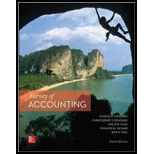
Ethical Dilemma Product cost versus selling and administrative expense
Emma Emerson is a proud woman with a problem. Her daughter has been accepted into a prestigious law school. While Ms. Emerson beams with pride, she is worried sick about how to pay for the school; she is a single parent who has worked hard to support herself and her three children. She had to go heavily into debt to finance her own education. Even though she now has a good job, family needs have continued to outpace her income and her debt burden is staggering. She knows she will be unable to borrow the money needed for her daughter’s law school.
Ms. Emerson is the chief financial officer (CFO) of a small manufacturing company. She has just accepted a new job offer. Indeed, she has not yet told her employer that she will be leaving in a month. She is concerned that her year-end incentive bonus may be affected if her boss learns of her plans to leave. She plans to inform the company immediately after receiving the bonus. She knows her behavior is less than honorable, but she believes that she has been underpaid for a long time. Her boss, a relative of the company’s owner, makes twice what she makes and does half the work. Why should she care about leaving with a little extra cash? Indeed, she is considering an opportunity to boost the bonus.
Ms. Emerson’s bonus is based on a percentage of net income. Her company recently introduced a new product line that required substantial production start-up costs. Ms. Emerson is fully aware that GAAP requires these costs to be expensed in the current accounting period, but no one else in the company has the technical expertise to know exactly how the costs should be treated. She is considering misclassifying the start-up costs as product costs. If the costs are misclassified, net income will be significantly higher, resulting in a nice boost in her incentive bonus. By the time the auditors discover the misclassification, Ms. Emerson will have moved on to her new job. If the matter is brought to the attention of her new employer, she will simply plead ignorance. Considering her daughter’s needs, Ms. Emerson decides to classify the start-up costs as product costs.
Required
- a. Based on this information, indicate whether Ms. Emerson believes the number of units of product sold will be equal to, less than, or greater than the number of units made. Write a brief paragraph explaining the logic that supports your answer.
- b. Explain how the misclassification could mislead an investor or creditor regarding the company’s financial condition.
- c. Explain how the misclassification could affect income taxes.
- d. Review the Statement of Ethical Professional Practice shown in Exhibit 10.19 and identify at least two ethical principles that Ms. Emerson’s misclassification of the start-up costs violated.
Trending nowThis is a popular solution!

Chapter 10 Solutions
Survey Of Accounting
- Bergen Corporation has an employee earning $8,400 per month. The FICA tax rate for Social Security is 6.2%, and the FICA tax rate for Medicare is 1.45%. The current FUTA tax rate is 0.6%, and the SUTA tax rate is 5.2%. Both unemployment taxes are applied to the first $7,000 of an employee's pay. The employee has $320 in federal income taxes withheld. The employee also has voluntary deductions for health insurance of $245 and contributes $180 to a retirement plan each month. What is the employee's net pay for the month of January?arrow_forwardCan you demonstrate the proper approach for solving this financial accounting question with valid techniques?arrow_forwardCan you help me solve this financial accounting question using the correct financial procedures?arrow_forward
- Which of the following is not part of the double-entry accounting system?a) Every transaction affects at least two accountsb) Debits must equal creditsc) Only one account is affected per transactiond) The accounting equation must remain balancedno aiarrow_forwardIn the first month of operations, the total of the debit entries to the cash account for Pulp Company amounted to $7,800, and the total of the credit entries to the cash account amounted to $5,250.What is the balance in the cash account at the end of the month?arrow_forwardPlease provide the correct answer to this general accounting problem using accurate calculations.arrow_forward
- Which of the following is not part of the double-entry accounting system?a) Every transaction affects at least two accountsb) Debits must equal creditsc) Only one account is affected per transactiond) The accounting equation must remain balancedarrow_forwardGive me Answerarrow_forwardPlease provide the solution to this financial accounting question with accurate financial calculations.arrow_forward
 Managerial Accounting: The Cornerstone of Busines...AccountingISBN:9781337115773Author:Maryanne M. Mowen, Don R. Hansen, Dan L. HeitgerPublisher:Cengage Learning
Managerial Accounting: The Cornerstone of Busines...AccountingISBN:9781337115773Author:Maryanne M. Mowen, Don R. Hansen, Dan L. HeitgerPublisher:Cengage Learning PFIN (with PFIN Online, 1 term (6 months) Printed...FinanceISBN:9781337117005Author:Randall Billingsley, Lawrence J. Gitman, Michael D. JoehnkPublisher:Cengage Learning
PFIN (with PFIN Online, 1 term (6 months) Printed...FinanceISBN:9781337117005Author:Randall Billingsley, Lawrence J. Gitman, Michael D. JoehnkPublisher:Cengage Learning





